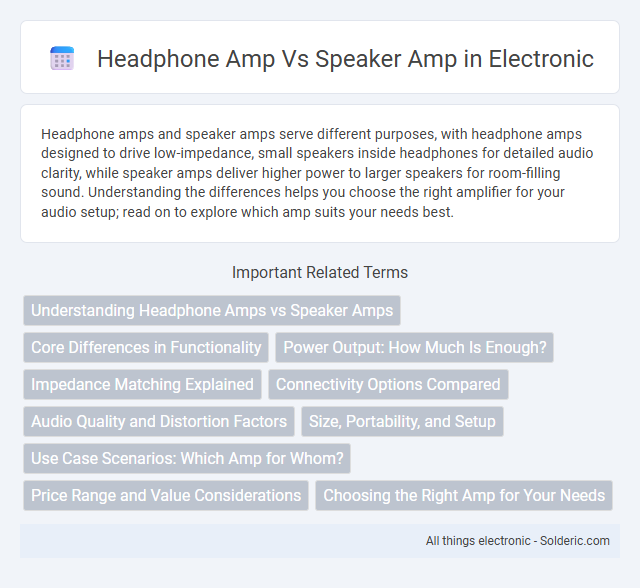Headphone amps and speaker amps serve different purposes, with headphone amps designed to drive low-impedance, small speakers inside headphones for detailed audio clarity, while speaker amps deliver higher power to larger speakers for room-filling sound. Understanding the differences helps you choose the right amplifier for your audio setup; read on to explore which amp suits your needs best.
Comparison Table
| Feature | Headphone Amplifier | Speaker Amplifier |
|---|---|---|
| Purpose | Amplifies audio for headphones | Amplifies audio for speakers |
| Output Power | Low power (mW to a few watts) | High power (watts to hundreds of watts) |
| Impedance Matching | Designed for low impedance (16-600 ohms) | Designed for higher impedance (4-16 ohms) |
| Load Type | High sensitivity, small drivers | Low sensitivity, larger drivers |
| Signal Drive | Delivers precise, clean audio with low noise | Drives higher current to move speaker cones |
| Physical Size | Compact, portable | Larger, often stationary |
| Applications | Personal audio, studio monitoring | Home audio, live sound, PA systems |
Understanding Headphone Amps vs Speaker Amps
Headphone amps are specifically designed to drive low-impedance, high-sensitivity headphones, delivering precise audio signals with minimal distortion and ample power for detailed sound reproduction. Speaker amps, or power amplifiers, are engineered to handle higher power output requirements and drive low-sensitivity, higher-impedance loudspeakers, providing robust amplification for room-filling audio. Understanding the electrical load and power demands of each amplifier type ensures optimal performance and protects audio equipment from damage.
Core Differences in Functionality
Headphone amps are designed to drive low-impedance, high-sensitivity headphones by providing precise voltage and current control, ensuring clear sound with minimal distortion at lower power levels. Speaker amps focus on delivering high power output to drive larger, higher-impedance speakers efficiently, often incorporating features like impedance matching and enhanced thermal management. Choosing between the two depends on your audio setup, as mixing them can lead to suboptimal performance or potential equipment damage.
Power Output: How Much Is Enough?
Power output requirements differ significantly between headphone amps and speaker amps due to their distinct impedance and sensitivity levels. Headphone amps typically deliver between 50 to 300 milliwatts, sufficient to drive headphones with impedances ranging from 16 to 600 ohms, ensuring clear and distortion-free sound. Your choice should consider headphone sensitivity and impedance to provide enough power without risking damage or distortion, whereas speaker amps demand several watts to hundreds of watts to effectively drive low-impedance speakers in various room sizes.
Impedance Matching Explained
Headphone amps are specifically designed to drive low-impedance loads typically ranging from 16 to 150 ohms, ensuring optimal power delivery and sound clarity by minimizing distortion. Speaker amps, on the other hand, cater to higher impedance loads between 4 to 8 ohms, providing sufficient voltage and current to power larger drivers effectively. Proper impedance matching between the amplifier and the audio device is crucial to maintain audio fidelity, prevent amplifier strain, and maximize efficiency in both headphone and speaker systems.
Connectivity Options Compared
Headphone amps often feature compact connectivity options such as 3.5mm jacks, USB ports, and Bluetooth support tailored for personal audio devices. Speaker amps typically include robust connections like binding posts, RCA inputs, and XLR terminals designed to handle higher power output and connect to larger speaker systems. Your choice depends on which devices you need to connect and the specific audio performance requirements for headphones versus speakers.
Audio Quality and Distortion Factors
Speaker amplifiers are designed to deliver higher power output to drive low-impedance loads such as speakers, emphasizing robust dynamic range and minimal harmonic distortion at high volumes. Headphone amplifiers focus on low power output with precise impedance matching and ultra-low distortion to preserve delicate audio details and stereo imaging. Distortion factors differ as speaker amps manage mechanical speaker-related distortions, while headphone amps prioritize minimizing electrical noise and crosstalk for optimal audio fidelity.
Size, Portability, and Setup
Headphone amps are compact, lightweight, and designed for easy portability, making them ideal for on-the-go listening and minimal space setups. Speaker amps are typically larger and heavier, requiring more room and often permanent installations for optimal performance. Headphone amps usually need fewer cables and simpler connections, while speaker amps involve more complex setups with multiple inputs, outputs, and sometimes external components.
Use Case Scenarios: Which Amp for Whom?
Headphone amplifiers are ideal for personal audio setups, such as studio monitoring or mobile listening, where driving high-impedance headphones with clarity and detail is essential. Speaker amplifiers are designed for louder, room-filling sound, suitable for home theaters, live sound systems, or music playback through passive loudspeakers. Choosing between a headphone amp and a speaker amp depends on the output device and listening environment, ensuring optimal power delivery and audio fidelity.
Price Range and Value Considerations
Headphone amps typically range from $50 to $1,000+, offering precise audio tuning for personal listening, while speaker amps start around $100 and can exceed several thousand dollars due to higher power output requirements. Your choice depends on whether you need portability and detailed sound for headphones or robust amplification for speakers, with headphone amps often delivering better value in smaller budgets. Consider the type of playback device and environment to ensure you invest appropriately in an amp that matches both your audio goals and budget.
Choosing the Right Amp for Your Needs
Choosing the right amp depends on whether you're driving headphones or speakers, as headphone amps supply precise, low-power signals tailored for high-impedance headphones, ensuring clear audio without distortion. Speaker amps deliver higher wattage to power larger speaker drivers efficiently, accommodating room size and speaker sensitivity. Understanding your audio setup and preferred listening environment helps determine if your needs align better with a headphone amp for personal use or a speaker amp for broader sound projection.
Headphone amp vs Speaker amp Infographic

 solderic.com
solderic.com